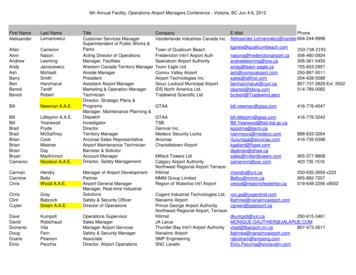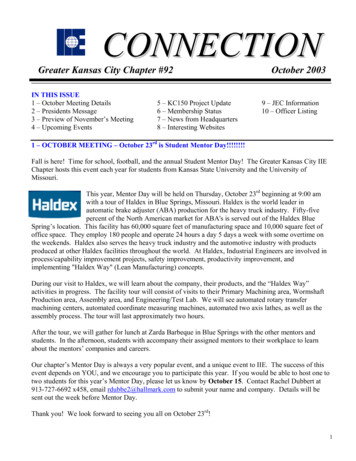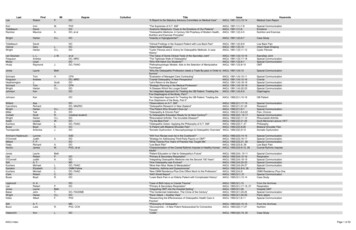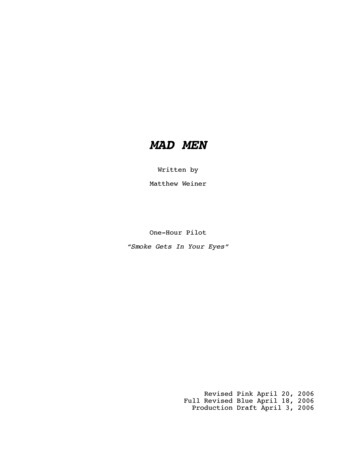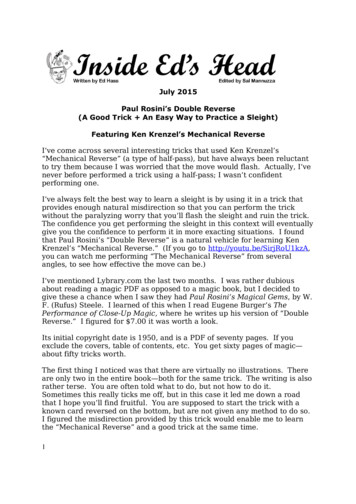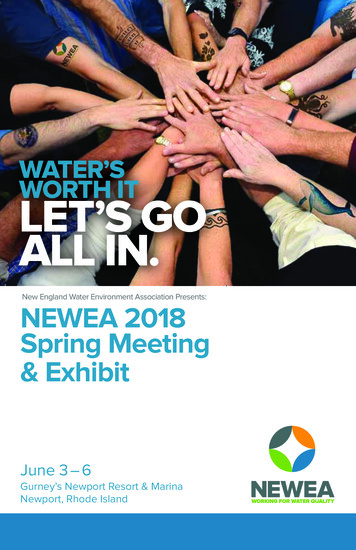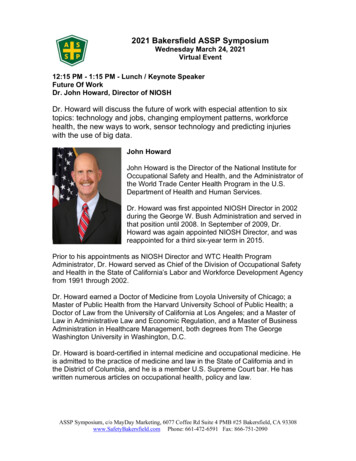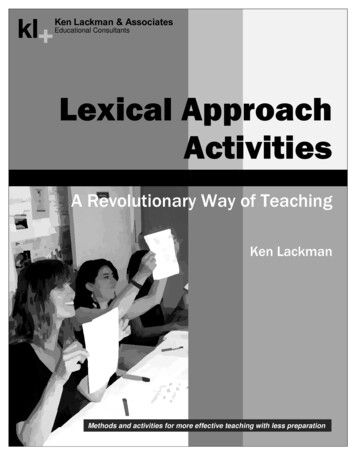
Transcription
kl Ken Lackman & AssociatesEducational ConsultantsLexical ApproachActivitiesA Revolutionary Way of TeachingKen LackmanMethods and activities for more effective teaching with less preparation
Lexical Approach IntroductionGrammar vs. LexisFeatures of the Lexical ApproachImplications for TeachingLexical Chunk ResourcesLexical Approach ActivitiesFind Someone Who SongsLexical Chunk DictationA Task-based ApproachCorpora SearchesPapers on WallsLexical Chunk Hot SeatSlot-filler Relay RaceSlot-filler SearchSuggestions for Teaching LexicallyRecommended BooksAppendix: Text-based Lexical Lesson Framework1
Lexical Approach ActivitiesIntroductionVery basically, a lexical approach to teaching means the primary focus ison helping students acquire vocabulary. This movement away from agrammar-based syllabus largely began in 1993 with the publication of “TheLexical Approach” by Michael Lewis. It was called an approach todifferentiate it from a method. In English language teaching, methods aresystems for structuring lessons while approaches are less concerned withhow the lesson is structured and more concerned with the general focus ofinstruction. Teachers should be aware of this as there is some reluctance toadopt a more lexical approach because of the fear that it may meanrevamping the way one teaches. In reality, teachers can use anymethodology with a lexical approach from grammar translation to taskbased learning. What changes is just the linguistic focus of the lesson.While one might think the paradigm shift was away from teaching grammarstructures towards teaching individual words, the linguistic focus of thelexical approach is really in between grammar and what we traditionallythink of as vocabulary. What it focuses on are structures made up of words,meaning that the actual paradigm shift was away from individual words toclusters of words, or lexical chunks as they are commonly referred to. Thisnew idea about the structural nature of the language does not excludegrammatical structures but instead recognizes that the language has farmore structures than those that occur in the grammatical syllabus. Considerthe statement below.The Lexical Approach is based on the idea that language is made up ofother structural elements besides what we traditionally think of asgrammar.In that statement, there are two distinct structures:“X is based on the idea/belief/premise that clause”“X is made up of Y”.Both of these structures occur fairly frequently in the language with differentvariables. Yet neither one would be found in a grammar book. In his book,Michael Lewis suggested that teachers need to help students becomeaware of the lexical structures that commonly occur in the language. Theidea is that if students become aware of some of the many lexicalstructures, they will have a lot more information about how to combineindividual words to build coherent structures like phrases, expressions andwhole sentences, which should ultimately emulate those used by nativespeakers. Many teachers have noticed that it is not use of grammar whichseparates higher level students from native speakers – often the student‟sgrammar will be better than a native speaker‟s – but the way words arecombined into lexical chunks.2
Lexical Approach ActivitiesGrammar vs. LexisGrammar has been the focus of language teaching for centuries, yet it isvocabulary, or more specifically, lexis, which learners need to negotiatemeaning. Consider the two groups of sentences below:Incorrect GrammarCorrect GrammarI go to zoo yesterday.I went to the zoo yesterday.I go to zoo now.I am going to the zoo now.I go to zoo tomorrow.I‟ll go to the zoo tomorrow.The first set of sentences is perfectly comprehendible because meaning iscarried not by grammar but by lexis. A listener would be able tounderstand what the speaker meant because of words like “go”, “zoo” and“now”. In reality, we do not have to be grammatically correct tocommunicate effectively, but we need to be correct with our use of lexis.Consider how drastically the meaning of the above sentences wouldchange if “tomorrow” was used instead of “yesterday” or if “park” was usedinstead of “zoo”.Correct LexisIncorrect LexisI go to zoo yesterday.I go to zoo tomorrow.I go to zoo now.I go to park now.I go to zoo tomorrow.He go to zoo tomorrow.A lexical mistake often causes misunderstanding, while a grammar mistake rarelydoes.John Sinclair, IATEFL 1996However unpopular it is with teachers, language which contains grammatical errorsis unlikely to be misunderstood in context, but with lexical errors misunderstanding,incomprehension, or in rare cases even offence, are quite likely. Recognizing thelexical nature of language, and the centrality of lexis to the creation of meaning,and consequently to communicative power, demotes grammar – and in particular,the often unnatural, inaccurate grammar of standard EFL – to a subsidiary role.Michael Lewis 1997Grammar has been the basis of language teaching for so long becausethere are a limited number of essential structures and they can be quiteeasily graded and organized into a syllabus. On the other hand, it‟s adaunting, if not impossible task to select vocabulary to focus on from alexicon that consists of millions of individual words and lexical structures.This is the reason that most coursebooks are based on a grammaticalsyllabus.3
Lexical Approach ActivitiesOne way that we can determine what vocabulary to focus on with learnersis by looking at what words are most frequently used by native speakers.Because of computers, we now have access to data indicating wordfrequency and lists such as the Academic Word List have become popular.It is interesting to look at the most frequent words of spoken English.The top 200 words represent about 60% of spoken language.The top 2000 words represent about 90% of spoken language.A surprisingly small number of individual words represent a very large partof the spoken lexicon. Most of the words which make up the top words ofspoken English are high in frequency because of how often they combinewith other words, many of them also on the high frequency list. Thefollowing chart of the most frequent words illustrates how these words cancombine with each other to produce combinations, or lexical chunks, wherethe meaning of the individual words can change once they are put together.All of the constructions on the right are made exclusively from the words inthe chart. There are many more that could be constructed from this list, andthousands more that could be constructed from the top 200, which is whythey represents 60% of spoken language. The top 2000 words wouldproduce hundreds of thousands of combinations.Most frequent 68words of lemeoutmytimewantanwilltakesomecouldmaketake totake intake that!take ontake uptake her outtake my timetake what you willtake what you can getget inget upget outget onget rightget one up onget up and goget with it!get what you canBecause these constructions, or chunks, often have their own usage and/ormeaning, it is essential that we do not focus on individual words whenteaching lexically, as so much of the language we commonly use is actuallymade up of combinations of the most frequent words. To use a simpleexample, words like “get”, “out”, “back”, etc. combine with each other toproduce numerous “lexical chunks” often with their own particular meaningand usage: e.g., “get out”, “out back”, “back out”, “get back”, “get back out”.4
Lexical Approach ActivitiesFeatures of the Lexical ApproachThe LexicalApproachis based on theideathatnotionpremiselanguage is made up of otherstructural elements besideswhat we traditionally think of asgrammar.assumptionbeliefNoun/Noun phrase is based on the abstract noun that clauseUsing the Lexical Approach requires the investigation of spoken and writtenlanguage in order to notice structures which are often ignored because theydo not fall into the categories determined by the traditional understanding ofgrammar. Outlining the form of these structures (see example above), helpsstudents acquire and use the structures and trains them to recognize otherones. The idea is not so much that students remember the structure ofvarious lexical chunks, for there are far too many to remember, but thatthey become aware of the structural nature of the language beyond thetraditional grammar structures. Once they have some awareness of howlanguage is chunked together, they are more likely to notice the how aparticular lexical chunk is structured and that dissection process is a stepnot only towards retaining that structure but also other structures like it.ConcordancePrintout[/h] Our philosophyIt is a package whichopposition to the mergerover time - whichof Andrews's theorisingOur forecast for 1996known. [p] Osteopathycity of Bremen. The ideaa rabbit out of a hatPortfolio managementwill ononononthethethethethethethethethethethebelief thatphilosophy whichargument that theconcept that apremise thatassumption thatnotion that theprinciple thatoriginal in whichconcept ofcoincidence of twoConcordance printouts (from corpora websites) can confirm that somethingis a lexical pattern. A concordance is simply a random sampling of extractsfrom spoken and written texts based around a selected word or phrase. Theconcordance sample above confirms that “is based on the” is indeed part ofa common lexical pattern (or “lexical chunk”). The concordance can alsoreveal more about the pattern. For example, it reveals that there is a nounor noun phrase before and after “is based on” and note the similarity someof the nouns that follow “is based on the”.When demonstrating variable structures to students, a group ofinterchangeable items may be shown as all being possible substitutions in aparticular part of the structure. In the example above, the five abstractnouns (idea, notion, etc.) are all shown as possible variables for that part ofthe structure. These are known as slot-fillers and we should usually keepthe number of slot-fillers dealt with to around five (many more can beoverwhelming) and where possible, the slot-fillers should be related insome way, e.g., abstract nouns for ideas/beliefs.5
Lexical Approach ActivitiesAs mentioned earlier, the Lexical Approach focuses not on individual wordsbut on clusters or chunks of words. Part of the reason for this is thatindividual words, particularly many of those which are high in frequency,can change meaning depending on the other words they are chunkedtogether with. The five sentences below indicate how the word “take” canchange depending on the words it is associated with.What‟s your take on this?It didn‟t take the first time.You need to take in the top a little bit.Have you taken into account the cost?Take the bull by the horns.The Lexical Approach consists of three main types of chunks:Types of Chunks Collocations: words of the four main parts of speech which gotogether, usually, but not always, two words. Fixed expressions: expressions which cannot be changed or canonly be changed minimally. Most fixed expressions are idiomatic orare those used in polite speech (e.g., How‟s it going?). Semi-fixed expressions: expressions which have at least one slotinto which a number of different words or phrases can be inserted.The list below indicates some of the lexical chunks in the five sentenceswith take. Below those are examples of how two semi-fixed expressionscan be broken down and expanded.Collocations: take in, first time, little bitFixed expressions: take the bull by the hornsSemi-fixed expressions: It didn’t take the , Have you taken into account takeworkIt didn‟thappenthe first Have you taken intopricetheratesexpenseslot-fillers6slot-fillers
Lexical Approach ActivitiesStudies have shown that learners tend to notice and remember words inchunks, particularly the ones which they consciously or unconsciouslyrecognize as variable (semi-fixed expressions) because they can perceivethat by changing the slot-filler, they can use the expression in many ways(it‟s “highly generative”). Imagine a learner sitting at the dinner table andhe/she hears the following:“Could you please pass the salt?”“Could you please pass the butter?”“Could you please pass the bread?”“Could you please pass the ketchup?”The learner will store the fixed part of the expression, “Could you pleasepass the ?” because their brain recognizes it as a structure which canbe varied and applied in different situations to achieve a communicativeend. Likewise in this popular song, the third line would be the most easilyacquired by a learner because of its generative value, i.e., it can be used ina variety of ways (with different names).Happy birthday to youHappy birthday to youHappy birthday dear MariaHappy birthday to you7
Lexical Approach ActivitiesImplications for TeachingThe average educated native speaker knows about 40,000 individual wordsand between 250,000 to 300,000 lexical chunks. If you were to teach 10items a lesson, five days a week, it would take about 120 years to teachthem all! This calculation is based on the recommended number of newitems that should be introduced in a lesson (10 – 15) and does not eventake into take into account the fact that studies have shown that a word(lexical item) must be encountered or used about seven times before it isacquired!What should become obvious is that we cannot teach the bulk of thelexicon. Then how do language learners go from absolute beginners tonative-speaker level in a relatively short time, often in less than ten years?The answer is that most of the lexicon is not overtly taught but incidentallylearned. Learners are constantly acquiring new lexical items whenever theycome in contact with the language, be it listening to the teacher talk inclass, watching a film or using the internet. Therefore, if the majority of lexisis incidentally learned, we should be focusing not on the tiny portion of thelexicon that we can “teach” in the classroom but on strategies to make theacquisition of the bulk of the lexicon more effective. How can we helpstudents more easily acquire language during their exposure to it, both inthe classroom and outside of it?The most important learning strategy we can give students is just to trainthem to NOTICE lexical chunks during their exposure to language. First wehave to raise their awareness of the fact that language consists of lexicalstructures, then we need to define the main types of lexical structures(collocations, fixed and semi-fixed expressions) and finally we need todevelop some activities that help them notice the lexical chunks in spokenand written texts.Once students have located the lexical chunks, they need to be analyzedso the learners can understand their construction, what they mean and howthey are and might be used. Again, in keeping with the idea that we aretrying to give students strategies to notice and process new language, thepurpose of analyzing the chunks is not so much so that studentsunderstand those particular chunks but, more generally, that they gainpractice in doing this sort of processing with new language and theydevelop some global knowledge of lexical structuring. To provide a simpleexample of this, if you have students find collocations in a text and thendetermine their structure, they will not only understand those collocationsbut they will be able to make some basic generalizations about collocations.Below are some collocations extracted from this paragraph.8
Lexical Approach ActivitiesCollocationFormlexical chunksAdj. Nkeeping with the ideaV Prep Ngive students strategiesV N Nprocess (new) languageV Ngain practiceV Nnew languageAdj Nglobal knowledgeAdj. Nsimple exampleAdj. Nbasic generalizationsAdj. NAs mentioned above, students not only become aware of the particularcollocations but they should be able to make more general assumptionsabout lexical structures. For example, two types of collocations seem to bemost common in the previous paragraph, adjective noun and verb noun. One might conclude that these are the most common types ofcollocation in English, but further investigation of other texts would revealthat that might be true for adjective noun collocations, but the frequencyof verb noun collocations is actually particular to this type of text, i.e., onethat gives instructions.The final step in the clarification stage with new lexical items is to illuminatethe usage by supplying some slot-fillers. This is a good thing to do forseveral reasons. Firstly, it gives students multiple new lexical chunks ratherthan just one. Also, it emphasizes the structure by giving students otherexamples of it. And finally, it gives students an idea of the generative valueof the structure, i.e., all the different ways it can be used.gaingetgiveprovide9practice
Lexical Approach ActivitiesLexical Chunk ResourcesLists of collocations and some fixed and semi-fixed expressions can befound in the Oxford Collocations Dictionary. Also, Scott Thornbury‟s NaturalGrammar has a two-page spread of common structures for each of the top100 words of the English language. There is sufficient material in each twopage spread so that a teacher could plan at least one lesson, if not two,around the structures featuring one particular key word. Below is anexample from the page featuring get.get [ NP ] to-infinitiveCan you get Tim to tidy his room? to talk about causing people to do thingsOne of the most valuable sources for lexical structures is corpora, hugedatabases of sampled English which can be searched for particularpatterns and then results can be organized to display the data in a way thatshows the different variations. There are many of these databases onlineand the following three are available free and are relatively easy to use.CorporaWebsitesLextutor (Choice of various rd e.htmlVery easy to use. It is not possible to choose the part of speech of thecollocates of your word but you can sort the words to the left or right of yourtarget word. See below for sorted words left of er of fact you could probably find a newoad sweep of the Hudson River there is a newre 12 is based on such a room built in a newidea of including its facility in their newps to the attic room which was to be his new3 1070 132.Full payment of nursingould receive up to 300 days paid-for nursingof general, not payroll, taxes. #NURSINGion dollar a year federal grants for nursinghome development in every populated county inhome development called "Oakwood Heights". As ahome in the Washington, D.C. area in the Springhome projects, by financing and installing thehome. Airless and dingy though it was, thehome bills for up to 180 days followinghome care under a "unit formula" allowing moreHOME CARE# The aged care plan carries thesehome construction. He asked for another 1010
Lexical Approach ActivitiesCobuild Concordance & Collocations Sampler (Bank of ch.aspxFor the Concordance Sampler, type your word or expression into the box.You can specify which parts of speech you want to come before or after itby using the Part-of-Speech tags. For example JJ house will give youadjectives which appear before “house” (JJ 2house will give you adjectivestwo positions before house i.e., 1 word in between).NOUNVERBNNNNSJJDTINRBVBa macro tag: stands for any noun taga macro tag: stands for any verb tagcommon nounnoun pluraladjectivedefinite and indefinite articleprepositionadverbbase-form verbboundaries, as a visit to any historichave been brought into the WhiteI'm well connected. A widower. My ownand seems to remember that the wholewho lives in Joseph's magnificent oldimportant match in front of a 43,000 fullI mean [ZF1] and [ZF0] and it was a lovelyto come into [ZF1] the [ZF0] the largeAnyway we think it's a niceI wish we had time to look at a cheaperachieved his goals Jaguar detachedVBNVBGVBDCCCSPPSPPOPPPDTGpast participle verb-ing form verbpast tense verbcoordinating conjunctionsubordinating conjunctionpersonal pronoun subject casepersonal pronoun object casepossessive pronoundeterminer-pronounhouse in the United Kingdom will prove. WhilstHouse. One adviser has suggested that therehouse. Nice car." He was mocking himself. Somehouse cost less than that to buy. It is hardhouse overlooking Scarborough harbour, said: house at the Parc des Princes. [p] At thehouse up [ZGY] barn [F01] Mm. [F02] ahouse where the father's got the banquet set.house don't we. [F0X] Oh I'm sure MX'll like it.house because if I'd known that I only had sixhouse Managing Directorship. But his comfortableBank of English11
Lexical Approach ActivitiesCorpus BYU EDU(British National Corpus & American Corpus)http://corpus.byu.edu/A little more complicated to use but extremely useful especially for listing inorder the most frequent collocates of particular words. Over 100 millionwords British and over 400 million American.Corpus BYU EDUNote in the box on the left that the selected word is “word” and to the rightof CONTEXT, the number 1 has been chosen in the first box to select thecollocations that come in the first space before our chosen word, in otherwords the words that come directly before “word”. If we had chosen 2, itwould have given us the words that collocate with “word” in the first twoplaces before it, i.e., it would have produced “have” because it is twopositions before word in the expression “to have a word with ”. If youselect a number in the second box, it will produce the collocations thatcome after the chosen word.Below the CONTEXT box, is the POS LIST box (Part of Speech List), fromwhere adj.ALL (all adjectives) was selected from the drop down list. Itshows up in the CONTEXT box as [aj*] and produces all the most frequentadjectives that collocate directly in front of “word”, e.g., single word, rightword, written word, etc. Note that you can also set the type of source in thetwo boxes below, e.g., “newspaper, academic, etc.”If you click on one of the collocates that is listed in the frequency list, theconcordance shows up below showing excerpts from the source containingthe collocation.12
Lexical Approach ActivitiesLexical Approach ActivitiesFind SomeoneWho onunciationWarmer/IcebreakerThis warmer is a standard activity which has been adapted to focus ondifferent lexical structures all involving the word “get”. It illustrates how TheLexical Approach is an approach, not a method, meaning it will work withexisting methodology and activities. In this case, it merely involved plantingthe lexical chunks into “find someone who ” instructions. This particularactivity could work with many other lexical chunks.Find someone who.likes to get their own way.takes a long time to get back to people.wants to get married.is getting together with friends the day after tomorrow.got out of bed on the wrong side today.has got to be at work early tomorrow.hasn‟t got over a break-up.often got into trouble at school.got his/her tonsils taken GrammarPronunciationWarmer/IcebreakerSongs are a rich source of lexical items, particularly commonly used semifixed expressions. When gapping song lyrics for use as a listening exercise,gap lyrics to get students to focus on useful lexical chunks rather thanindividual words. An example below:I Will - The BeatlesGapping songsGiving cluesWho [knows how long] I’ve loved you[You know I]love you stillWill I wait a lonely lifetimeIf [you want me too],I willLove you forever and forever,Love you [with all my] heart.Love you [whenever we‟re together]Love you [when we‟re apart]For [if I ever] saw youI didn’t [catch your name]But it never really matteredI will always [feel the same]And when [at last] I find youYour song will fill the airSing it loud [so I can] hear youMake it [easy to be] near youFor the [things you do] endear you to meYou know I willYou can also ask students to listen for certain constructions by supplyingthem with clues for each one. Or if you want to make it easier for them, givethem a written copy of the lyrics along with the instructions See examplebelow.13
Lexical Approach ActivitiesBrown Eyed Girl - Van MorrisonHey where did we go,Days when the rains cameDown in the hollow,Playin' a new game,Laughing and a running hey, heySkipping and a jumpingIn the misty morning fog withOur hearts a thumpin' and youMy brown eyed girl,You my brown eyed girl.Whatever happenedto Tuesday and so slowGoing down the old mineWith a transistor radioStanding in the sunlight laughing,Hiding behind a rainbow's wall,Slipping and slidingAll along the waterfall, with youMy brown eyed girl,You my brown eyed girl.Find the following collocations and expressions.1. A question about where you went with someone.[Where did we go?]2. A question about what became of something that existed in the past.[Whatever happened to.?]3. A collocation to describe someone‟s physical appearance.[brown eyed]4. An expression for where something is that cannot be seen.[Hiding behind a. ]Lexical ularyGrammarPronunciationWarmer/IcebreakerThis is a quick and easy way to guide students towards lexical chunks thatyou want them find in a text. First you need your own copy of the text. Thenon your text, underline some of the lexical chunks you want students to lookfor. Then give students a copy of the text and have them work in pairs. Tellthem you are going to dictate a list of clues for structures in the text andthey have to write down the clues. When you are dictating them, givestudents some clues about their form and the meaning e.g., “A noun plusnoun collocation for a type of weather.” (morning fog). Once you havedictated them all, students work in pairs and find them in the text. If youwant, you can make it a competition to see who can find them all first. Seethe example below for “Brown eyed girl”.Hey where did we go,Days when the rains cameDown in the hollow,Playin' a new game,Laughing and a running hey, heySkipping and a jumpingIn the misty morning fog withOur hearts a thumpin' and youMy brown eyed girl,You my brown eyed girl.14Whatever happenedto Tuesday and so slowGoing down the old mineWith a transistor radioStanding in the sunlight laughing,Hiding behind a rainbow's wall,Slipping and slidingAll along the waterfall, with youMy brown eyed girl,You my brown eyed girl.
Lexical Approach Activities1. A four-word question about a past habit.[Where did we go?]2. A noun plus noun collocation for a type of weather[morning fog]3. A noun plus verb collocation for a physical response to excitement[hearts thumping]4. A collocation to describe someone‟s physical appearance.[brown eyed]5. A question about what became of something that existed in the past.[Whatever happened to.?]A ocabularyGrammarPronunciationWarmer/IcebreakerA good way to get students to notice lexical chunks in a text is to tell themthat they will have to use those chunks later in a task. The task shouldrelate to the original text. For example, if students were to read aboutsomeone‟s experience on a holiday, their task could be to describe aholiday that they had or would like to have and they would have to look forlexical chunks that they could use for that task. The source could also be aspoken text. Keeping with the holiday idea, an easy way to do this in aclass is to tell students about a holiday you had and ask them to write downany chunks (e.g., expressions) that they think they could use when theydescribe their holiday. Not only is this an effective classroom activity but itteaches students a valuable strategy for language acquisition, that beinglistening or reading for useful language that you can use later.Often the type of task you can assign becomes obvious when you look atthe original text. For example, with the song “I will” (see above) the finaltask could be to write a love letter. Below are some chunks that studentscould extract to do that task.You know I love you.If you want me to Whenever we‟re together I will always feel the samewith all my heartwhen we‟re apartwhen we‟re togetherOf course, once the students have extracted the language, you should getvariable chunks up on the board and, where possible, elicit other slot-fillersthat could be used. This is to give students some latitude with the chunkswhen they finally do their productive task. If the productive task is writing,you can specify that you want students to use a certain number of chunks.You know I lovelikeadorecare about15you.
Lexical Approach ActivitiesIf you want a really easy way to assess this task, you could ask students tounderline the ones they used and award them a score based on how manythey have. Below is an example of a student‟s writing done in this waybased on an article about citizenship.Brazil is a country full of possibilities but citizenship is underestimateddue to the fact that people don't trust the country's political organization.Young people don't enjoy working towards the betterment of one'scommunity. They don't want to serve in the army, or do volunteer work.Although it's a country with freedom of religion, they don't enjoy going tochurch. They often agree about denying political duties but demandingtheir political privileges.It's safe to conclude that Brazil needs to be encouraged to increasethe young people's sense of citizens
Grammar vs. Lexis Grammar has been the focus of language teaching for centuries, yet it is vocabulary, or more specifically, lexis, which learners need to negotiate meaning. Consider the two groups of sentences below: Incorrect Grammar Correct Grammar I go to zoo yesterday. I went to the zoo yesterday. I go to zoo now. I am going to the zoo now.
